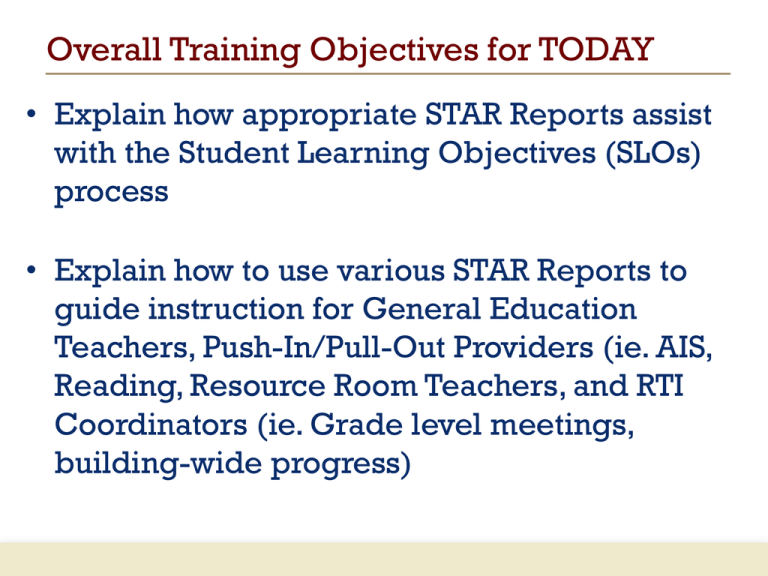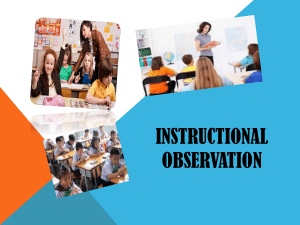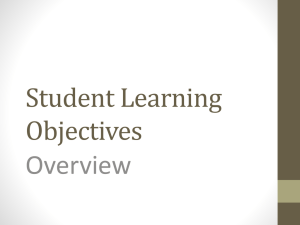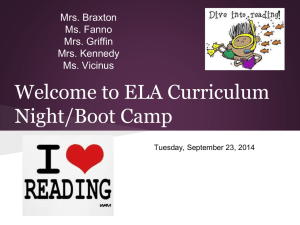
Overall Training Objectives for TODAY
• Explain how appropriate STAR Reports assist
with the Student Learning Objectives (SLOs)
process
• Explain how to use various STAR Reports to
guide instruction for General Education
Teachers, Push-In/Pull-Out Providers (ie. AIS,
Reading, Resource Room Teachers, and RTI
Coordinators (ie. Grade level meetings,
building-wide progress)
Agenda
• Oath of Confidentiality for any individual student
data viewed today
• View Sample Elementary APPR Chart
• Review Sample SLOs
• Which STAR Reports are referenced to collect info for:
• “Baseline” Section of the SLO
• Setting K(or PreK) – gr. 2 Individual Student Targets
• Setting Targets for gr. 3+ students taking NYS Assessments
• How exactly does STAR calculate Moderate Growth Targets? (Amy)
• What if I want to change the them? Can the system help me recalculate? (Amy)
Oath of Confidentiality
To maximize today’s training I may see data
and scores for a school, teacher, or student
other than my home district. I promise to be
professional and only discuss this
information for training purposes today. I will
not discuss any of other district’s information
with anyone after today’s training.
Creating
Student Learning Objectives
(SLOs) Using STAR Reports
View Sample District Chart
Review Sample SLOs
Which STAR Reports are referenced to collect info for:
1). “Baseline” Section of the SLO
2). Setting K(or PreK) – 2 Individual Student Targets
3). Setting Targets for gr. 3+ students taking NYS
Assessments
4). How exactly does STAR calculate Moderate Growth
Targets? (Amy)
5). What if I want to change the them? Can the system
help me re-calculate? (Amy)
EXAMPLE District Decision Chart
Growth Measure
LocallySelected
Measure
Gr. 1
1 SLO ELA and Math
STAR SGP for all
GROWTH MEASURE
LOCALLY-SELECTED
MEASURE
based on STAR
Early
students on
K
1 SLO with 3 party assessment from NYSED’s State-approved list
Literacy results
roster
(e.g., Terra Nova):ELA
1SLO with 3 party assessment (e.g., Terra Nova):Math
SLO with
Gr.
2
1
SLO
ELA
based
on
STAR
SGP
for all
District-developed writing assessment
1
STAR Reading Projected students on
Moderate Growth Targets roster
1 SLO Math based on
STAR Math Projected
Moderate Growth Targets
rd
rd
st
Module 6
7
STAR SGP Testing Window Options
Default SGP Windows
Option 2 SGP Windows
Fall: Aug. 1 to Sept 30
Fall: Sept. 1 to Oct. 31
Winter: Dec. 1 to Jan. 31
Winter: Jan. 1 to Feb. 28
Spring: April to May 30
Spring: May 1 to June 30
• Both options use the same methodology and are equally
valid.
• Adhere to testing windows for SGP calculation to be
derived
• To request Option 2 have the Renaissance Place
Administrator at your district email support@renlearn.com
to change their SGP reporting window
All SLOs MUST include the following basic components:
Population
These are the students assigned to the course section(s) in this SLO - all students who are assigned to the course section(s) must be included in the SLO.
(Full class rosters of all students must be provided for all included course sections.)
Three sections of ELA 9, heterogeneously grouped, 70 students.
Learning
Content
Interval of
Instructional
Time
What is being taught over the instructional period covered? Common Core/National/State standards? Will this goal apply to all standards applicable
to a course or just to specific priority standards?
Read and comprehend complex literary and information texts independently and proficiently. Write arguments to support claims
in an analysis of substantive topics or texts using valid reasoning and relevant and sufficient evidence.
What is the instructional period covered (if not a year, rationale for semester/quarter/etc)?
2012-2013 school year.
What specific assessment(s) will be used to measure this goal? The assessment must align to the learning content of the course.
th
Baseline assessment: 8 Grade ELA results. Common writing prompt: Students provide an objective summary of Frederick
Douglass’s Narrative. They analyze how the central idea regarding the evils of slavery is conveyed through supporting ideas and
developed over the course of the text.
Evidence
Summative assessment: Ten reading comprehension questions based on the selection rom Things Fall Apart. Ten reading
comprehension questions based on Quindlen, Anna. “A Quilt of a Country.” Newsweek September 27, 2001. Students determine
the purpose and point of view in Martin Luther King, Jr.’s, “I Have a Dream” speech and analyze how King uses rhetoric to
advance his position (in writing).
What is the starting level of students’ knowledge of the learning content at the beginning of the instructional period?
Baseline
On last year’s ELA 8: 4% scored 1; 18% scored 2; 67% scored 3, 11% scored 4.
On the four-point district-wide writing rubric: 15% scored 1; 40% scored 2; 30% scored 3, 15% scored 4.
Target(s)
What is the expected outcome (target) of students’ level of knowledge of the learning content at the end of the instructional period?
Eighty percent of all students will score 55 points or higher on the summative assessment (out of a possible 64 points).
Target(s)
What is the expected outcome (target) of students’ level of knowledge of the learning content at the end of the instructional period?
Eighty percent of all students will score 55 points or higher on the summative assessment (out of a possible 64 points).
How will evaluators determine what range of student performance “meets” the goal (effective) versus “well-below” (ineffective), “below” (developing),
and “well-above” (highly effective)?
See ranges as specified.
HEDI Scoring
HIGHLY
EFFECTIVE
EFFECTIVE
DEVELOPING
INEFFECTIVE
20
19
18
17
16
15
14
13
12
11
10
9
8
7
6
5
4
3
2
1
0
99100%
9798%
9596%
9294%
8891%
8587%
8284%
7981%
7678%
7375%
7172%
6870%
6467%
6063%
5759%
5356%
4952%
4548%
4044%
3039%
<30
%
Describe the reasoning behind the choices regarding learning content, evidence, and target and how they will be used together to prepare students for
future growth and development in subsequent grades/courses, as well as college and career readiness.
Rationale
The Learning Content is based on the most important CCLS anchor standards. The baseline evidence combines state test
th
scores with an on-demand assessment taken from the 8 grade performance tasks in Appendix B. Similarly, the summative
th
assessment is based on the performance tasks for 9 grade in Appendix B. The summative score is calculated by adding twice
of the number of comprehension questions answered correctly with the total score on the district-wide writing rubric (which has
6 elements on a 1-2-3-4 scale which translates to a maximum 24 points).
Baseline
Describe how students performed on the identified preassessment(s) for the learning content. Baseline scores for
students should be reviewed by teacher and Lead
Evaluator when setting the SLO at the beginning of the
course.
STAR Report to obtain this summary – Screening Report
Baseline
What specific assessment(s) will be used to measure this goal? The assessment must align to the learning content of the course.
Baseline: A district-generated running record assessment will be conducted during September, employing running records to assess
nd
instructional reading level (should be @ Level J for beginning 2 grade); a word assessment (students should know 220 ‘service words’
st
st
by the end of 1 grade); and a phonics inventory (students should have mastered CVC, CVCE, blends, & digraphs by the end of 1
grade).
Evidence
Summative Assessment: A district-generated running record assessment will be conducted in June, employing running records to assess
instructional reading level (will be scored for words per minute and accuracy %) and a phonics inventory (including long/ short vowels,
vowel teams, 2 syllable words w/ long vowels, words w/ prefixes and suffixes).
IEP testing accommodations will be used (extended time, alternate location)
What is the starting level of students’ knowledge of the learning content at the beginning of the instructional period?
st
1. The students (5) with IEP’s are reading on an early 1 grade instructional level. They identify all letters and consonant sounds.
They are inconsistent in reading blends and digraphs. They can identify short vowel sounds in isolation, but are inconsistent in
nd
applying that knowledge when reading. They are reading less than 5 words per minute on beginning 2 grade selections (Level
J).
st
Baseline
2. The students (6) receiving AIS instruction are reading on a mid-1 grade level. They identify all letters and consonant sounds,
read cvc, ccvc, and cvcc words. They are inconsistent when reading v-c-e words in isolation. They are reading between 9 and 15
nd
words per minute on beginning 2 grade selections (Level J).
3. The remaining students are reading an average of 20 words per minute with an accuracy rate of 87% (Level J). They can identify
vowel teams in isolation but are inconsistent in applying this to unfamiliar words in context.
4. Knowledge of sight words is highly variable.
What is the expected outcome (target) of students’ level of knowledge of the learning content at the end of the instructional period?
Target(s)
Target(s)
This is the level of knowledge and skill that
students are expected to achieve at the end point
of the interval of instructional time.
Define numerical growth goals for student
performance on identified summative
assessment(s) which measure student knowledge
and skill in the learning content. These data will be
reviewed by the teacher and Lead Evaluator at the
conclusion of the course.
Target(s)
What is the expected outcome (target) of students’ level of knowledge of the learning content at the end of the instructional period?
All students will have individual goals based on the pre-assessment; the target for the teacher is based on the aggregation of the
individual growth.
Target(s)
Students will increase sight words by at least 1 word per week. (30 words)
Fluency will increase at least 20 words per minute at an accuracy rate of 90%
Instructional Reading Level will increase by 3 levels
85% of students will reach their individual goals.
How will evaluators determine what range of student performance “meets” the goal (effective) versus “well-below” (ineffective), “below” (developing),
and “well-above” (highly effective)?
HEDI Scoring
HIGHLY
EFFECTIVE
20
19
18
EFFECTIVE
17
16
15
14
13
12
DEVELOPING
11
10
9
8
7
6
5
INEFFECTIVE
4
3
2
1
0
Describe the reasoning behind the choices regarding learning content, evidence, and target and how they will be used together to prepare students for
future growth and development in subsequent grades/courses, as well as college and career readiness.
Rationale
What is Acceptable Growth?
What Student Progress Meets Expectations?
Performance
Level
END: 1
END: 2
END: 3
END: 4
START: 1
NO
YES
YES
YES
START: 2
NO
YES
YES
YES
START: 3
NO
NO
YES
YES
START: 4
NO
NO
YES
YES
Obtaining Individual Student Target(s)
STAR Report to obtain Projected Moderate Growth
Targets
• Instructional Planning Report by Student
• K/1 – Early Literacy – starting date of last
testing window
• Gr. 2 – Reading and Math – starting date of
last testing window
• Gr. 3 Reading – NYSTP and April 16 NYS ELA
• Gr. 3 Math – NYSTP April 24 NYS Math
• How exactly does STAR calculate Moderate
Growth Targets? (Amy)
• What if I want to change them? Can the
system help with re-calculating?
Using STAR Reports for Instructional Purposes
Growth Wizard
Progress Monitoring Report
Diagnostic Report
Instructional Planning
Growth Report & Growth Proficiency
Report –
•Student Growth Percentile
• Embedded Instructional Tools
•
•
•
•
•
Setting Goals with STAR
Growth Models
Building the Model
Typical rates of growth for
similarly-scoring students
Access to 34,000,000+
STAR assessments in
2010 - 2011.
© 2010 Renaissance Learning, Inc. All rights reserved. PO Box 8036, Wisconsin Rapids, WI 54495 Phone: (800) 338-4204
| Fax: (715) 424-4242
110812
Statistics Behind the Goal-Setting Wizard
1st
K
1
2
3
4
5
6
7
8
9
10
11
12
2nd
3rd
4th
5th
6th
7th
8th
9th
10th
The Goal-Setting Wizard
Goal Setting Wizard
See goal and
calculated growth rate*
Change goal
duration or set new
intervention and
goal
(after 4 scores)
Name the intervention
and set goal
end date
Click Calculate
Goal
Set up or
define goal
20
The Student Progress Monitoring Report
Where is the student
now?
What is the goal the
student needs to reach?
When did the
intervention start?
Is the student
on target to
reach the goal?
How has the student been
scoring over
time or since
the intervention?
What is the
actual rate of growth
(trend)?
21
Instructional Planning Report—Student
What is a student’s current
and projected performance?
How can I see how a
skill fits into a learning
progression?
Which skills
is a student
ready to learn
next?
24
Flexible Grouping
•
•
•
How many groups can you
manage?
When and how will you provide
differentiated instruction?
Who will you include in which
group?
25
In the spring, Kellie scored equal to or higher
than
42% of her academic peers.
Typical
Growth
1
35
50
65
99
Examining Growth Data
Tyler Grade 6
Above Benchmark
Kianna Grade 6
Intervention
Kianna Grade 6
Intervention
28
Teacher View
29
Instructional Tools
30
AR BookFinder & Goals of CCLS Text Complexity
31









